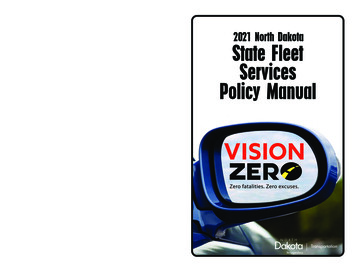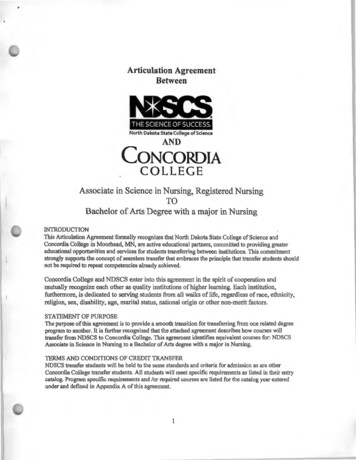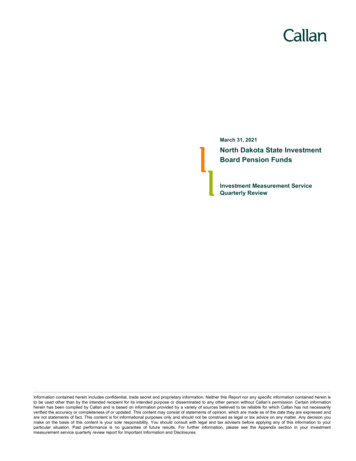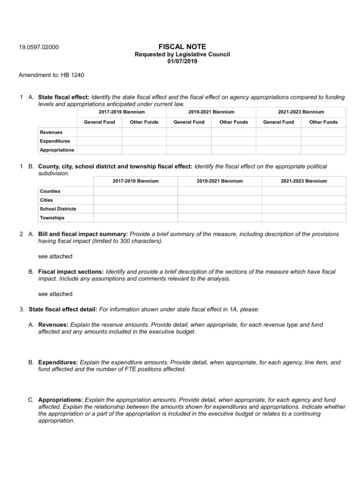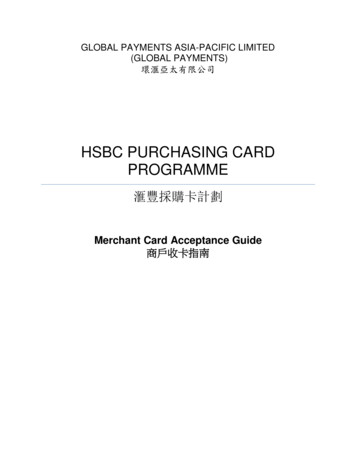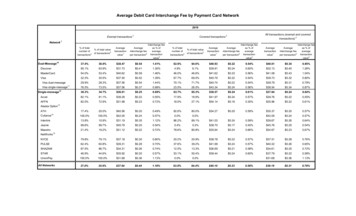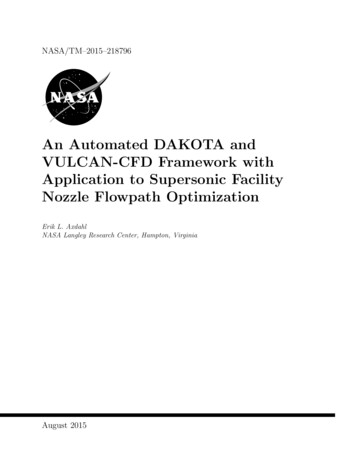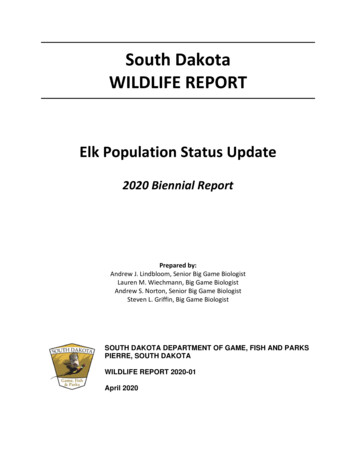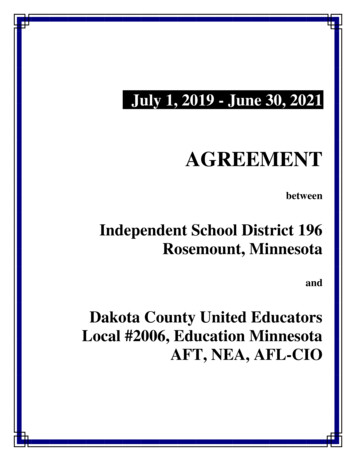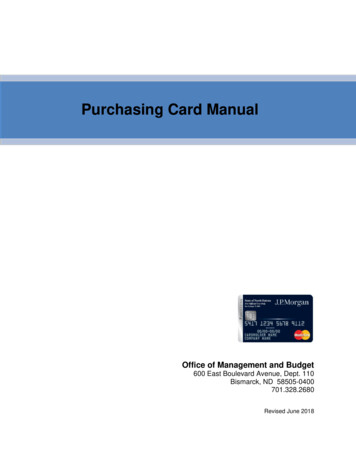
Transcription
Purchasing Card ManualOffice of Management and Budget600 East Boulevard Avenue, Dept. 110Bismarck, ND 58505-0400701.328.2680Revised June 2018
Purchasing Card ManualIntroductionThe Purchasing Card (P-Card) is a MasterCard through JPMorgan Chase and is administered bythe Office of Management and Budget.P-Cards offer state agencies the opportunity to streamline their procedures for procuring andpaying for goods and services. The p-card program delegates the authority and capability ofpurchasing items directly to designated cardholders. It is a method of payment for employeesto make purchases for official agency business. The p-card program reduces the volume ofaccounts payable transactions and the associated administrative costs by eliminating vendorinvoices and consolidating multiple vendor payments into one monthly payment to JPMorganChase.While the use of a p-card leads to accounting efficiencies, agencies must maintain strict internalcontrol over the use of cards and ensure that relevant procurement guidelines are observed,especially those detailing the use of state contracts. The p-card should be viewed at all times asan efficient means of payment, not a substitute for proper procurement procedures. Thefollowing policies and procedures apply to the use of the p-card by all agencies of the state ofNorth Dakota.Procurement CertificationAll cardholders must follow procurement rules when making purchases. The OMB ProcurementOfficer Certification Program was created in 2002 to provide employees responsible forpurchasing with training related to the type of procurement they conduct. The Programconsists of four levels of procurement complexity. Level 1 Certification is for purchases less than 10,000;Level 2 is for purchases up at least 10,000 but less than 50,000;Level 3 Certification is for purchases at least 50,000 but less than 100,000; andLevel 4 Certification is for purchases 100,000 and over.All cardholders must complete the Level 1 Certification Course, excluding cardholders who areissued a p-card strictly for travel purposes only (MCC Group of 962). If applicable, Level 2, Level3, and Level 4 may also be required. Cardholders should complete the required certificationprior to activation of their p-card. OMB may periodically require Procurement OfficerRecertification training.RolesProgram Administrator (PA)Program Administrators (PA) are employed by the Office of Management & Budget. They areresponsible for management and operation of the p-card program.1 Page
Purchasing Card ManualCard Administrator (CA)Each agency is represented by a Card Administrator (CA). The CA is designated by their agencydirector and is responsible at the agency level for administering the p-card program. CardAdministrator Change Request (SFN 59054) must be completed to add or delete a cardadministrator. To ensure adequate internal controls, a CA cannot be a cardholder.Card HolderA cardholder is an employee who has been assigned the responsibility to purchase goods andservices for their agency. P-cards may be issued to full or part time employees. Card holders arerequired to complete a Card Holder Employee Agreement (SFN 59053) and submit it to theiragency card administrator.Reallocator/ProxyA reallocator/proxy reviews all transactions that have been downloaded into PeopleSoft andmakes any necessary changes to the accounting distribution lines. ConnectND FinancialsSecurity Access Request (SFN 54418) must be completed with the NDS ALL PCARD role added.You must be assigned proxy to each cardholder to view and reallocate their transactions. Acardholder can also be assigned proxy to their own account and reallocate their transactions.ConnectND Financials Security Access Request (SFN 54418) must be completed with theNDS ALL PCARD REALLOCATOR role added. Instructions to add proxy to p-card accounts andreconcile transactions.ResponsibilitiesCard Administrator Sign and maintain original Card Holder Employee Agreement (SFN 59053) forms. Issue p-card accounts to cardholders within PaymentNet. Ensure accuracy and periodically review cardholders MCC group, limits and speed chart. Routinely monitor cardholder activity within agency. Ensure p-cards accounts are promptly closed and destroyed upon termination orseparation from employment. Assists with disputed charges that cannot be resolved by the cardholder. Notify program administrators of any misuse of the p-card. Maintain accurate records for audits. Distributes information from program administrators to cardholders. Responsible for overseeing that all reallocation is completed in the time allotted foreach cycle. At the end of each billing cycle, process a monthly cardholder/company statementreport in PaymentNet. This is considered your JPMorgan Chase central bill statement. Run NDSALL PCARD JP CURRENT STMT or NDSALL PCARD JP CURRENT STM AP (forthe business units that have separate AP units) query in PeopleSoft for each billing cycle.2 Page
Purchasing Card ManualVerify totals on cardholder statements, monthly cardholder/company statement report,PeopleSoft query and screen print from the Payments Tab on your agency’s voucher inPeopleSoft.Cardholder Complete and sign Cardholder Employee Agreement Form (SFN 59053) and submit tocard administrator. Comply with all policies and procedures relating to the use of the p-card. Abuse ormisuse may result in disciplinary action up to and including termination and possiblecriminal charges. Return the p-card upon transfer, leave of absence, termination, retirement or uponrequest to card administrator. Immediately report lost or stolen p-cards or fraudulent charges to JPMorgan Chase andcard administrator. Retain receipts for all purchases. Identify disputed items and contact merchant directly to resolve issue. Ensure the physical security of the p-card. Attach receipts to monthly statement, sign statement and submit documents todesignated agency official for approval.PaymentNetPaymentNet is JPMorgan Chase’s internet-based p-card system. It is a secure website, which ishosted and maintained by JPMorgan Chase. PaymentNet is available to card administrators andcardholders.Cardholder Employee Agreement FormsThe Cardholder Employee Agreement Form (SFN 59053) signifies that the cardholder agrees tocomply with the Purchasing Card Manual and agreement. All cardholders are required to signthe agreement and submit it to their card administrator before a p-card can be issued.Billing CycleThe program operates on a monthly billing cycle. The billing cycle will end on the last businessday of the month.ReceiptsOriginal receipts are required for all transactions. The receipts should include merchant name,transaction amount, date and itemized description of item(s) purchased. Credits are alsoconsidered a transaction and require a receipt.3 Page
Purchasing Card ManualSplitting PurchasesThe splitting of transactions is prohibited. Split transactions occur when a transaction exceedsthe cardholder’s limit and the transaction is split into two or more transactions to bypass thelimit.Cardholder LimitsSingle Amount LimitThis limit allows card administrators to designate the maximum dollar amount allowed forcardholders to spend on each transaction.Credit LimitThis limit allows card administrators to designate the total amount a cardholder can spendduring the monthly billing cycle.Card administrators should set the limits based on the cardholder’s need/usage. Limit changessaved in PaymentNet go into effective immediately and can be changed permanently ortemporarily.Merchant Category Code (MCC) and Merchant Category Code Groups (MCCG)Merchant Category Codes (MCC) are codes assigned by a merchant’s acquiring bank based onthe types of goods and/or services provided. By allowing or blocking certain codes, the Statehas some protection against unauthorized or prohibited purchases.Merchant Category Code Groups (MCCG) are a subset of MCC codes that are allowed in thatparticular group. MCCG are established and defined by the State as follows:ND950Allows purchases of most goods and services.Restricts travel, lodging, cash, entertainment, food, or liquor.ND951In addition to 950, it will also allow airline tickets, conferences, carrentals, lodging, food and meals (should not be used for per diem meals).Restricts cash, entertainment, or liquor.ND952Allows purchases of most items.Restricts jewelry, cash, etc.ND962Used for travel related items only (airline, car rental, lodging,transportation and fuel)4 Page
Purchasing Card ManualTravelThe p-card can be used for most travel expenses. Travel must be for official business for thestate of ND. The p-card should not be used for per diem food allowance.Allowable types of travel expenses include: Conference registration fees Airfare Lodging 1 Car rental All ground transportation costs Hotel and Airport Parking Luggage charges 21 Thecost of the room, internet access for business purposes, business phone calls and parkingat the hotel are acceptable p-card purchases. Any incidental expenses are the responsibility ofthe employee and must be processed on the employee’s personal credit card.2Employees should be reimbursed for their first piece of checked luggage. It is up to eachagency to decide if employees should be reimbursed for additional checked luggage,overweight luggage and subsequent charges.Sales Tax ExemptPurchases made by cardholders are exempt from paying ND sales tax. Cardholders areresponsible for informing merchants of the tax-exempt status before initiating a transaction.This includes telephone and internet purchases. The state of ND’s tax exempt number isembossed on the card. If tax was charged, the merchant should be contacted immediately for arefund to the p-card. The cardholder is responsible for getting the tax refunded.1099 ReportingThe merchant’s issuing bank is responsible for issuing 1099’s for purchases made with a p-card.As a result, the p-card can be used for all 1099 reportable purchases. If a 1099 reportablepurchase is not made using a p-card, the agency is responsible for issuing a 1099 for thosepurchases.Returns, Credits, Disputed ItemsReturns and Credits: When a return is made, the credit should be issued on the cardholder’sp-card. Do not accept a refund in cash, gift card or check form. The credit may appear on thesame billing statement as the original charge or on a subsequent billing statement. Maintaindocumentation of all credits, returns, and exchanges. The documentation should be attached tothe monthly cardholder’s statement.Disputed Items: Individual cardholders are responsible for following up with the merchant onany erroneous charges, disputed items, or returns as soon as possible. Disputed items can5 Page
Purchasing Card Manualresult from failure to receive the goods charged, defective merchandise, incorrect dollaramounts, duplicate charges, credits not processed, as well as fraud and misuse.If the cardholder has an issue with a purchased item or billing resulting from use of the p-card,the cardholder should first try to reach a resolution with the merchant. In most cases, disputescan be resolved directly between the cardholder and the merchant.If the cardholder has a disputed charge and cannot reach resolution with the merchant, thecardholder or card administrator must dispute the charge in PaymentNet within 60 days fromthe transaction date.Declines at Point of SaleIf a cardholder is declined at the point of sale, the cardholder should contact their agency cardadministrator. The card administrator has the ability to view the declined transaction and makethe necessary adjustments to the account within PaymentNet.Some reasons for a decline include: The cardholder has failed to activate the card by calling the toll free number listed onthe sticker placed on the front of the card. The cardholder has exceeded the designated single amount limit or monthly credit limit. The cardholder attempts to use the card for a blocked merchant category code (MCC).P-Card SecurityP-cards are issued with the name of the cardholder and the cardholder’s agency nameembossed on the front of the p-card. Authorized use of the p-card is limited to the personwhose name appears on the front of the p-card. The use of the p-card results in a liability to theagency not a personal liability for the cardholder. The cardholder’s credit rating will not beaffected. However, it is important to remember that the cardholder agrees to the terms andconditions in the Cardholder Employee Agreement (SFN 59053) and is personally liable for anymisuse of the p-card. JPMorgan Chase provides liability protection to the state once notificationof any loss, theft, or fraudulent use is made. However, the same level of liability protectiondoes not apply to p-cards that are made available to multiple users.General Guidelines for Cardholders and Card Security Sign the back of the p-card upon receipt. Only the person whose name appears on the card is authorized to use the card. Cardholders should retain the p-card in a secure location. Never make a photocopy of a card. Never fax or e-mail the entire account number. Should only be used on secured internet sites6 Page
Purchasing Card ManualReporting Lost or Stolen P-CardsReport lost or stolen p-cards immediately to your agency card administrator and JPMorganChase. To report a lost or stolen p-card to JPMorgan Chase, call 1-800-270-7760. This number isavailable 24 hours a day/7 days a week.Card SuspensionProgram and card administrators have the ability to suspend cards. This option can be used forvarious reasons including: History of abuse Not retaining receipts for all purchases Cardholder is on extended period of leave such as Military, Disability, Medical, Seasonal,etc.Termination of Employment or Transfer to Another AgencyUpon termination of employment or transfer to another state agency, the cardholder mustreturn the p-card to their agency’s card administrator. The card administrator mustimmediately close the account in PaymentNet and destroy the p-card.Random AuditsOMB and Office of the State Auditor may conduct random audits of p-card use. The primarypurpose of the audit is to ensure that: P-card program and state procurement procedures are being followed. The p-card is being used for appropriate transactions. Supporting documentation is complete.Cardholder StatementsA monthly cardholder statement is available electronically within PaymentNet It is thecardholder’s responsibility to reconcile their monthly statement with their receipts. Ifinaccuracies and/or erroneous information exist, the cardholder must immediately notify theiragency card administrator. The cardholder should sign the monthly statement and submit italong with the receipts to the designated agency official for approval.The cardholder’s supervisor, card administrator or another designated employee (other thancardholder) should: Review information submitted by cardholder. The reviewer should match receiptsto the cardholder statement submitted by the cardholder. Verify purchases are for state business use only. Sign cardholder statement tocertify that purchases comply with appropriate rules and regulations to the best ofthe reviewer’s knowledge. Verify that no personal transactions are on statement. If personal transactionsoccur, the employee must repay the state, including any applicable sales tax. Eventhough tax is not charged by the merchant, the employee must remit the tax to the7 Page
Purchasing Card ManualState Tax Commissioner. If it is determined that personal or other unauthorizedcharges are occurring on the p-card, appropriate steps, up to and includingdismissal, will be taken to resolve the misuse/abuse of the p-card.Payment to JPMorgan ChaseThe p-card is individually billed and centrally paid by OMB. Once the billing cycle hascompleted, OMB will download the transactions from PaymentNet into PeopleSoft using thedefault speed chart that has been assigned to each cardholder. Agencies will be notified bye-mail when the transactions have been downloaded and will be given a timeframe of whenthey can reallocate or make changes to the default coding before payment is processed inPeopleSoft. If the transactions are not reallocated within the timeframe, they will be processedas is using the default coding and will have to be adjusted later by a journal voucher inPeopleSoft. OMB will create the vouchers in PeopleSoft to generate payment to JPMorganChase. Agencies will need to make a screen print from the payments tab on the voucher inPeopleSoft and attach it to their monthly p-card statements.Records Retention SchedulePer the general records retention schedule created by Information Technology Department, therecords retention for p-card records is three years.011505PURCHASING CARD RECORDSDescription: This series contains the purchase card report, statement, and otherinformation related to purchasing cards used by the agency.Retention: Three years after the current fiscal year.Disposition: Dispose by shredding.Authority: NDCC 44-04-18.9ContactsProgram AdministratorsRenae Heller328-4936Doreen Schumacher 328-2682Renee Nelson328-2680JPMorgan Chase Customer Service - 1-800-316-6056JPMorgan Chase Program Coordinator – 1-800-969-3519(Agency Card Administrator Use Only)8 Page
same billing statement as the original charge or on a subsequent billing statement. Maintain documentation of all credits, returns, and exchanges. The documentation should be attached to the monthly cardholder’s statement. Disputed Items: Individual cardholders are responsib
